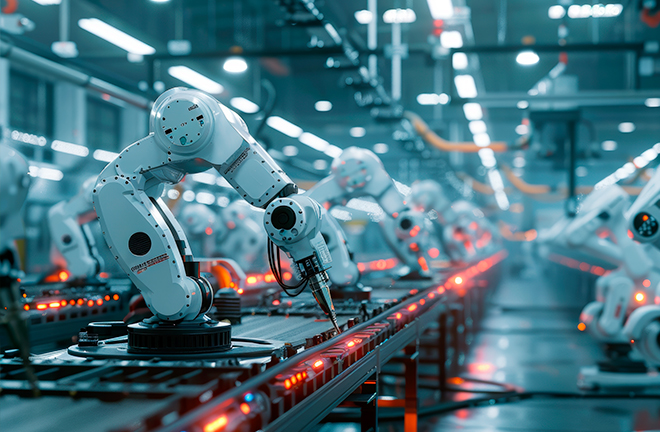Innovation lies at core of new quality productive forces

Smart manufacturing Photo: TUCHONG
During his inspection tour of northeast China’s Heilongjiang Province in September 2023, General Secretary of the Communist Party of China (CPC) Central Committee Xi Jinping introduced a new term: “new quality productive forces.” He urged efforts to integrate resources for sci-tech innovation to guide the development of strategic emerging industries and future industries, so as to form new quality productive forces. On Jan. 31, 2024, Xi emphasized accelerating the development of new quality productive forces and making solid progress in promoting high-quality development when chairing the 11th group study session of the Political Bureau of the CPC Central Committee.
Basic connotation
New quality productive forces are relative to traditional productive forces, manifested in qualitative leaps of human abilities to utilize and transform nature, with the potential to significantly advance social development.
A review of the human history of productive force development suggests that science and technology are consistently the pivotal variables in fostering and developing new quality productive forces. Competition between countries around the world, particularly between major countries, is fundamentally a rivalry in science and technology, or the development of new quality productive forces.
As General Secretary Xi Jinping pointed out, in a nutshell, new quality productive forces are primarily driven by innovation, and break free from traditional economic growth modes and productivity development paths; they feature high technology, high efficiency, and high quality, and are advanced productivity required by the new development philosophy. They are shaped by revolutionary technological breakthroughs, innovative allocation of production factors, and deep industrial transformation and upgrading, with the improvement of labor forces, means of labor, subjects of labor and their optimal combination as underlying elements, and a substantial increase in total factor productivity as a core hallmark. Marked by innovation, and with high quality as the key, new quality productive forces are advanced productivity in essence.
Internal mechanism
The internal mechanism of productive forces, as a complex system, can be explained by the following two processes, when these forces undergo cyclical development and realize an upward spiral from quantitative to qualitative changes, and from low- to high-level generations.
First, the innovative development of power technology fuels changes in elements of productive forces, contributing to the “generational” progress of productivity in general. In terms of elements of productive forces, the improvement of laborers’ skills, continuous upgrade of production instruments, and expansion and enrichment of the scope of labor objects will all boost the formation of new quality productive forces.
As a prominent hallmark of productivity level, the efficiency of production instruments plays a decisive role in the system of productive forces, affecting the development of other elements. Power technology is central to the efficiency of production instruments. In the history of social development, several productive force revolutions were triggered by changes in production instruments.
From production instruments powered by natural forces, such as watermills, to fuel-based, steam-powered tools, on to electricity-powered instruments, every disruptive innovation of power technology has revolutionized production instruments and reshaped the entire system of productive forces. Therefore, the innovative development of power technology directly determines the efficiency of production instruments, and further influences the contribution of other elements of productive forces, accelerating the formation and development of new quality productive forces.
Second, the innovative restructuring of productive forces’ elements as a result of new empowerment technology can substantively improve productivity. The elements of productive forces combine in different ways with different technologies on different levels, thus unleashing different degrees of productivity.
On the micro level, new empowerment technology will recombine laborers, means of labor, and objects of labor in the production process, catalyzing changes in the modes of production and organization, nurturing emerging enterprises, and enhancing enterprises’ production capacities.
On the meso level, new empowerment technology will bring changes to industrial factor resources, the degree of industrial concentration, industrial spatial distance, and industrial architecture, spawning new industries, business formats, and business models, and increasing the productivity of the whole industry.
Institutionally, new empowerment technology will empower government administration, social governance, market operation, and corporate operation in an all-around manner, and strengthen the institutional efficacy of the entire society. Hence the means of production and market behaviors will be effectively regulated, alongside efficient distribution of labor products, leading to constant adjustments and reforms to production relations, in order to emancipate productive forces.
Today as science and technology develop rapidly, the continuous innovation of new energy technology and development of digital empowerment technology together are transforming traditional productive forces into new quality productive forces in a shorter cycle and at a faster speed.
Jiang Yongmu is a professor and dean of the School of Economics at Sichuan University. Ma Wenwu is an associate professor from the College of Marxism at Sichuan University.
Edited by CHEN MIRONG
